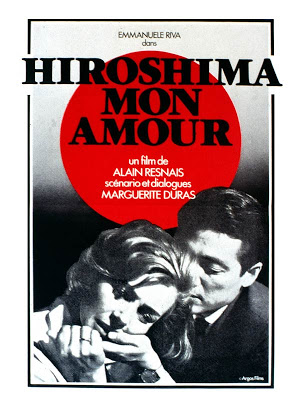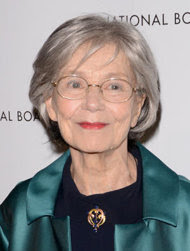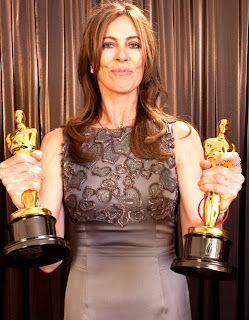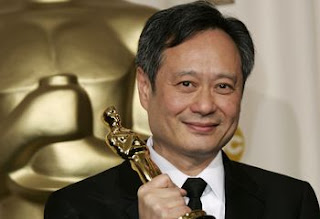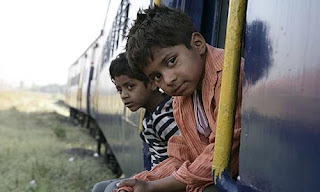Hiroshima mon amour debuted in 1959, 14 years after Hiroshima and Nagasaki were bombed. Alain Resnais’ first feature film explores memory, forgetting and tragedy on an individual and worldwide scale, largely through the lens of Elle (“Her”), played by Emmanuelle Riva.
While Resnais had signed on to do a documentary about the atomic bomb, he concluded that it should be fictional and “that the impact of Hiroshima would be refracted through the viewpoint of a foreign woman,” according to critic Kent Jones. Resnais wanted Marguerite Duras, a French writer and later film director, to write the screenplay.
Duras’ command of literature, dialogue and feminist sensibilities resonate in the film (Duras was nominated for an Academy Award for the screenplay). Hiroshima mon amour, which grounds itself in the brief affair of a French woman and a Japanese man (Lui, “Him,” played by Eiji Okada) in Hiroshima, is as much about the growth and healing of an individual in a partnership as it is about nations healing after the second World War.
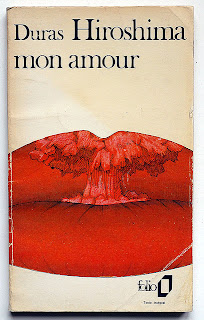 |
| Marguerite Duras wrote the screenplay, a stream-of-consciousness conversation with a focus on the feminine. |
This juxtaposition of the feminine (love, emotion, peace) and the masculine (war, possession, destruction) shows that neither exists in a vacuum.
The first section of the film shows Elle and Lui’s naked bodies intertwined, and their dialogue–dominated by her thoughts–is accompanied by increasingly awful footage of the aftermath of the bomb. She talks about how she visited the museum in Hiroshima: “… the reconstructions, for lack of anything else… the explanations, for lack of anything else.” She looked at the photographs and the scorched metal. She says, “What else can a tourist do but weep? I’ve always wept over Hiroshima’s fate.” As she “remembers,” Lui interjects that she remembers nothing, that she knows nothing and that there was nothing for her to weep over.
Elle was a young woman in occupied France (Nevers) when she learned the bomb dropped. Lui was fighting in the war, and his family was in Hiroshima. As the narrative unfolds and Elle comes to terms with her past, her youth and madness that she had in Nevers was due to her intense love with a German soldier–the enemy–who was killed right before they were set to leave together.
Lui’s story doesn’t seem as important as hers. We know he’s married (they both are), and that he’s a successful architect and involved in politics. His role in the film is that of a lover, of course, a pursuer and a listener.
Elle, fighting Lui’s claims that she doesn’t know anything about Hiroshima, stresses that she does know. She says she knew that women risked giving birth to “monsters,” men risked becoming sterile, huge amounts of food had to be thrown away and that the “principle of inequality” kept advancing–between races and classes. He tells her she knows nothing, but we hear her concern with the traditionally feminine, even feminist, cultural and human ramifications of this new warfare.
Her memory and knowledge, from a French perspective, also symbolizes the difficulties that others have in attempting to remember and to understand tragedies on foreign soil.
When this introductory collage of words and images ends, the couple’s faces are shown, laughing in bed. They are individuals now, not just ideas.
He asks, “What did Hiroshima mean to you in France?”
She answers, “The end of war. I mean, completely.” She couldn’t believe they did it and that they succeeded.
“The whole world rejoiced, and you rejoiced with it,” he says.
 |
| Elle and Lui share passion and memory. |
Their conversations, although heavy, are rooted in a desire and growing love for one another. The beginning conversation sounds uncomfortable since Lui is denying Elle’s memory and understanding, but they weave themselves together and her memories become lucid as the story unfolds. And Lui listens and falls deeper in love with her.
This prevailing theme of memory and understanding, and the limitations of both, are a product of a unique film production–Japanese and French companies and crews produced it, and the producers demanded that one star be French and the other Japanese. Even the production of the film highlights this partnership and what can be possible when cultures partner. Resnais and Duras, the creative team, show the great power of giving creative license to both the masculine and feminine.
Elle is in Hiroshima acting in a film about “peace,” and when Lui finds her on set, they are filming actors protesting with signs about nuclear testing and photos from after Hiroshima. Much like the setting of Hiroshima itself, these scenes provide a backdrop to the individual love affair of a couple while reminding the audience of worldwide pain and tragedy.
Elle describes her memory of her past in Nevers (after Lui asks her about it). When she first asks why he asked about Nevers, Lui says he understands that she “was young, and didn’t belong to anyone in particular. I somehow understand that you began to be who you are today.”
She fell in love with a German soldier, and he was killed. She stayed by his cold body while the cathedral bells celebrated the liberation of Nevers (again, showing the complex perspectives of victory for some and tragedy for others). Her family is shunned since she was a “disgrace,” and her head is shaved. When she screams, she’s locked in the cellar until she becomes “reasonable,” and her mother sends her to Paris.
When she arrives in Paris, Hiroshima is “in all the papers.” She says, “Fourteen years have passed–I still remember the pain a little bit, but one day I will no longer remember it. At all. Nothing.”
Lui asks if her husband knows this story, and she says no. “So I’m the only one?” he asks, and she replied that he is. He is elated, and embraces her. His possession of her memories signifies a deepening of their relationship and a new found trust. That, or he’s simply happy to have something of hers that only he possesses.
In an internal dialogue after leaving Lui (who begs her to stay), Elle speaks to her German lover, and says that she’s found another impossible love, and that she’s told her story. She is terrified of forgetting him.
 |
| Elle splashes water on her face and she is reborn after telling the story of her “youth” and “madness” in love. |
When she and Lui walk the streets together and her thoughts dominate the narrative, scenery from France and Japan flash back and forth, confusing time and place. Elle says, “I meet you. I remember you. This city was tailor-made for love. You fit my body like a glove. Who are you? You’re destroying me. I was hungry. Hungry for infidelity, for adultery, for lies and for death. I always have been. I had no doubt you’d cross my path one day…”
She is attracted to and comforted by Lui, but her journey is much more introspective. He continuously chases after her, but she knows that “staying is more impossible than leaving.”
Her climactic thought is “Silly little girl who died of love in Nevers–I relinquish you into oblivion.”
She doesn’t really, though, nor should she.
They visit a cafe late at night (Casablanca, a clear nod to another film of “impossible love”), and the sun begins to rise overhead. Lui follows Elle back to her hotel room. She cries, “I’ll forget you! I’m forgetting you already!” This is a threat and a mournful realization all at once. She says, slowly, “Hiroshima,” and he covers her mouth. “Hiroshima,” she repeats. “That’s your name.
“Yes, that’s my name,” he says. “And your name is Nevers. Nevers in France.”
The sweeping narrative begins with discussion of place, of warfare and mass casualties narrows in on a couple, and a woman’s struggle with remembering, forgetting and mourning her past. At the end, they are again representative of their places in the world, and a complex, difficult history.
Hiroshima mon amour, as a cornerstone film in the
French New Wave movement of the late 1950s and 1960s, offers us no answers or prescriptions for life. Instead, we are left aching–both for the “impossible” romance and the pain and emptiness of modern war.
The beginning of the film inundates us with images from after the bomb. As we drift farther into the narrative and farther away from those horrifying images, we forget what we saw. We forget the horrors. Hiroshima mon amour forces us to reflect on the power of memory, and more so, the power of forgetting.
Throughout the film, the relationship between the masculine and the feminine, remembering and forgetting and dealing with war from different perspectives tugs and pulls at Elle and Lui and at the audience. At the end, the impossible is made penetrable by accepting and absorbing these complex relationships all at once.
—–
Leigh Kolb is a composition, literature and journalism instructor at a community college in rural Missouri.



